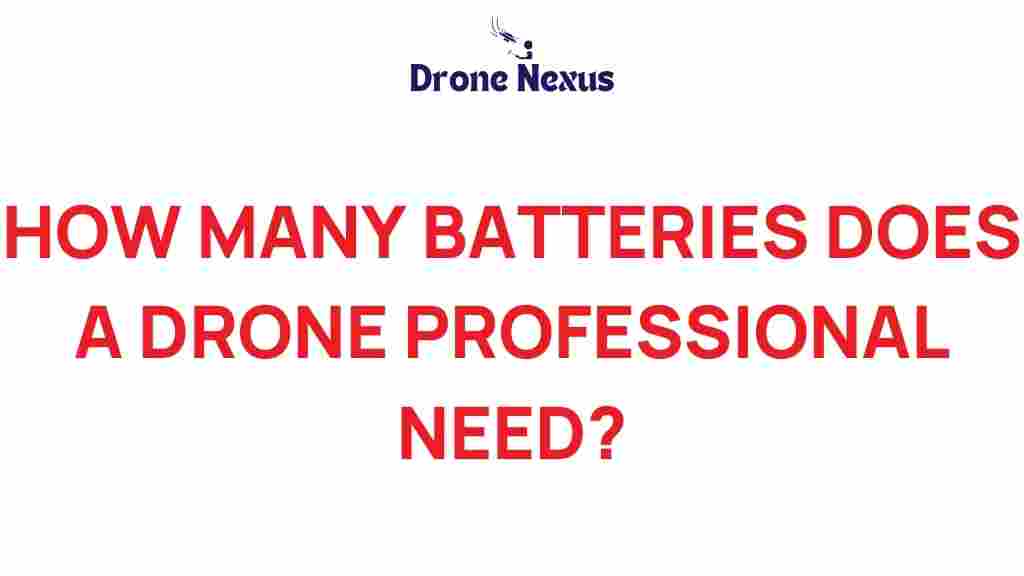Unveiling the Battery Needs of Professional Drones: How Many Drone Batteries Do You Really Need?
As the popularity of drones continues to soar, understanding drone batteries becomes increasingly essential for both hobbyists and professionals. Whether you’re using drones for aerial photography, surveying, or agricultural monitoring, the battery life can significantly impact your workflow and efficiency. In this article, we will explore the various aspects of drone batteries, helping you determine how many you really need for your professional operations.
The Importance of Drone Batteries
Drone batteries are the lifeblood of any unmanned aerial vehicle (UAV). They power the drone’s propulsion system and onboard electronics, influencing flight time and performance. Here are some reasons why understanding your drone battery needs is crucial:
- Flight Time: The amount of time a drone can stay airborne is directly tied to its battery capacity.
- Operational Efficiency: Professionals often require multiple flights in a single day, necessitating an adequate battery supply.
- Project Requirements: Different projects have varying needs, which can affect how many batteries you’ll need.
Assessing Your Drone Battery Needs
To determine how many drone batteries you need, follow this step-by-step process:
Step 1: Identify Your Drone Model
Different drone models have varying battery specifications. Check the manufacturer’s guidelines to find:
- Battery type (LiPo, Li-ion, etc.)
- Battery capacity (measured in mAh)
- Flight time per charge
Step 2: Calculate Your Average Flight Time
Your average flight time is crucial for planning how many batteries you will need. Keep in mind:
- Environmental conditions can affect flight time.
- Payload weight can also impact how long your drone can stay in the air.
For instance, if your drone has a flight time of 25 minutes under optimal conditions, you can use this as a baseline for your calculations.
Step 3: Estimate Your Daily Usage
Think about how many flights you will conduct in a day. For example:
- If you plan on flying 6 times a day with each flight lasting 25 minutes, you’ll need to factor in battery recharges.
- Consider the time it takes for batteries to recharge and how that fits into your schedule.
Step 4: Determine Your Battery Requirements
Using the information gathered, you can now calculate how many drone batteries you will need:
- Estimate the total flight time needed for the day.
- Divide your total daily flight time by the average flight time per battery.
- Consider having at least two extra batteries for backup in case of malfunctions or delays.
For example, if you need 150 minutes of flight time in a day and each battery lasts 25 minutes:
- 150 minutes / 25 minutes per battery = 6 batteries needed
- Add at least 2 extra batteries for a total of 8 batteries.
Types of Drone Batteries
Understanding the different types of drone batteries available can also help in making informed decisions:
1. Lithium Polymer (LiPo) Batteries
LiPo batteries are the most common type used in drones due to their high energy density and lightweight nature. They come in various configurations:
- Common capacities range from 1000mAh to 20000mAh.
- They require careful handling and proper charging to avoid risks like puffing or explosion.
2. Lithium-Ion (Li-ion) Batteries
Li-ion batteries are typically used in larger drones or those requiring longer flight times. Advantages include:
- Higher energy density than LiPo.
- Longer lifespan and more stable under various conditions.
3. Nickel-Metal Hydride (NiMH) Batteries
While less common in professional drones, NiMH batteries are used in some hobbyist models. They offer:
- Less energy density compared to LiPo and Li-ion.
- Greater durability and resistance to damage.
Maintaining Your Drone Batteries
Proper maintenance of drone batteries is crucial for longevity and performance:
- Always store batteries at a partial charge (around 40-60%) to prolong lifespan.
- Use a balance charger for LiPo batteries to ensure even charging across cells.
- Monitor battery health regularly; look for signs of swelling or damage.
Troubleshooting Common Battery Issues
Even with proper care, issues can arise with drone batteries. Here are some common problems and their solutions:
1. Shortened Flight Times
If you notice that your drone’s flight time has decreased:
- Check the battery’s health and age; older batteries naturally lose capacity.
- Ensure you are not exceeding the drone’s weight limit, which can drain the battery faster.
2. Slow Charging
If your batteries are taking longer to charge:
- Inspect the charger; a faulty charger can slow down the charging process.
- Verify that the battery connectors are clean and free from debris.
3. Overheating
If batteries feel hot to the touch during charging:
- Stop charging immediately and allow them to cool down.
- Check for any damage to the battery; swollen or damaged batteries should not be used.
Conclusion
In conclusion, understanding the drone batteries you need for your professional operations is essential for maximizing efficiency and productivity. By assessing your flight needs, calculating the number of batteries required, and maintaining them appropriately, you’ll ensure that your drone operations run smoothly. Always consider the specific requirements of your drone model, and don’t hesitate to invest in extra batteries to avoid downtime during critical projects.
For more in-depth information on drone technology, visit this resource.
If you have any specific questions or need further guidance, feel free to explore our drone community forum.
This article is in the category Accessories and created by DroneNexus Team
